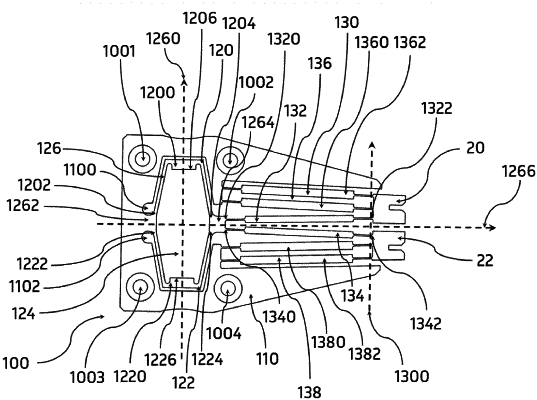| CPC B25J 7/00 (2013.01) [B25J 9/0015 (2013.01)] | 14 Claims |

|
1. A device for a microactuator comprising
a body (110),
two terminal members (20, 22) articulated (136, 138; 236, 238) on the body (110), located on one side of the body (110),
two deformable bowl-shaped walls (120, 122) which face one another, arranged to house an actuator (30), two respective first edges (1202, 1222) of said walls (120, 122) located on one side being fastened (1264) on the body (110), whereas two respective second edges (1204, 1224) of said walls (120, 122) located on another side move consecutively to a deformation of the walls (120, 122) under the effect of the actuator (30),
said movement being transmitted by two arms (132, 134) which terminate at the two respective terminal members (20, 22)
wherein the bowl-shaped walls (120, 122) each have a respective bottom (1200, 1220) against which the actuator (30) bears,
wherein the deformation of the actuator (30) is a longitudinal expansion or a longitudinal contraction against the two bottoms (1200, 1220) of the walls (120, 122),
wherein an expansion of the actuator (30) against the two bottoms (1200, 1220) drives a coming closer together of the first edges (1202, 1222) and of the second edges (1204, 1224), by which the second edges (1204, 1224) symmetrically drive a relative coming closer together of the terminal members (20, 22) via arms (132, 134), and
wherein a contraction of the actuator (30) against the two bottoms (1200, 1220) drives a moving apart of the first edges (1202, 1222) and of the second edges (1204, 1224), by which the second edges (1204, 1224) symmetrically drive a relative moving apart of the terminal members (20, 22) via arms (132, 134).
|